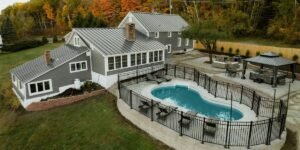Understanding Historic Interiors
Preserving and restoring historic interiors is a delicate process that involves various challenges and techniques. The goal is to maintain the historical integrity of a building while adapting it to meet contemporary needs. This article explores the complexities involved in this process and discusses how to balance historical authenticity with modern functionality.
Historic interiors are spaces within buildings that have significant cultural, historical, or architectural value. These interiors often reflect the design, materials, and craftsmanship of a particular period. Preserving these spaces is essential to maintaining our cultural heritage and ensuring that future generations can experience and learn from the past.
Challenges in Preserving Historic Interiors
Preserving historic interiors presents several challenges, including:
1. Deterioration of Materials
Over time, materials used in historic interiors can deteriorate due to factors like age, environmental conditions, and usage.
- Aging Materials: Original materials such as wood, plaster, and textiles may weaken or decay over time.
- Environmental Damage: Exposure to moisture, sunlight, and fluctuating temperatures can accelerate the deterioration process.
- Wear and Tear: Continuous use of the space can lead to wear and tear, further compromising the integrity of materials.
2. Modern Functional Requirements
Adapting historic interiors to meet modern needs without compromising their integrity is a significant challenge.
- Building Codes: Modern building codes and safety standards may require alterations that can impact the historical features of the interior.
- Technology Integration: Incorporating modern amenities like HVAC systems, electrical wiring, and internet connectivity can be challenging in historic settings.
- Accessibility: Ensuring that historic interiors are accessible to people with disabilities often requires modifications that must be carefully planned to preserve historical elements.
Techniques for Preserving Historic Interiors
Several techniques can be employed to preserve and restore historic interiors while maintaining their historical integrity:
1. Research and Documentation
Thorough research and documentation are essential before beginning any preservation project.
- Historical Research: Study the history of the building and its interiors to understand the original design, materials, and craftsmanship.
- Photographic Documentation: Take detailed photographs of the interiors to document their current condition and guide the restoration process.
- Archival Records: Review archival records, blueprints, and previous restoration efforts to gather comprehensive information about the interiors.
2. Conservation of Original Materials
Wherever possible, original materials should be conserved and restored rather than replaced.
- Cleaning and Repair: Carefully clean and repair original materials using appropriate conservation techniques to preserve their integrity.
- Stabilization: Stabilize deteriorating materials to prevent further damage and maintain their structural integrity.
- Reversible Methods: Use reversible methods for repairs and modifications so that future restorers can easily undo them if necessary.
3. Sympathetic Restoration
Sympathetic restoration involves using materials and techniques that match the original construction as closely as possible.
- Matching Materials: Source materials that closely match the original ones in terms of composition, texture, and appearance.
- Traditional Techniques: Employ traditional craftsmanship techniques to ensure that restorations blend seamlessly with the original work.
- Patina Preservation: Preserve the natural patina of materials, as it contributes to the historical character of the interiors.
Balancing Historical Integrity and Modern Functionality
Balancing historical integrity with modern functionality requires careful planning and consideration. Here are some strategies to achieve this balance:
1. Minimal Intervention
Adopt a minimal intervention approach to maintain the historical authenticity of the interiors.
- Respect Original Features: Preserve original features and elements as much as possible.
- Subtle Modifications: Make subtle and unobtrusive modifications to integrate modern amenities without altering the historical character.
2. Adaptation with Sensitivity
When adaptations are necessary, carry them out with sensitivity to the historical context.
- Discreet Installations: Install modern systems like HVAC and electrical wiring discreetly to minimize their visual impact.
- Hidden Technology: Conceal modern technology within existing features or custom-built enclosures that blend with the historical design.
3. Collaboration with Experts
Work with preservation experts, architects, and craftsmen who specialize in historic interiors.
- Expert Guidance: Seek guidance from professionals with experience in historic preservation to ensure that the project adheres to best practices.
- Interdisciplinary Approach: Adopt an interdisciplinary approach that combines expertise in history, architecture, engineering, and conservation.
Preserving and restoring historic interiors involves a delicate balance between maintaining historical integrity and meeting modern functional requirements. By employing thorough research, conservation techniques, and sensitive adaptations, it is possible to preserve the unique character of historic interiors while ensuring they remain functional and relevant. The ultimate goal is to honor the past while accommodating the needs of the present, creating spaces that can be enjoyed by future generations.











